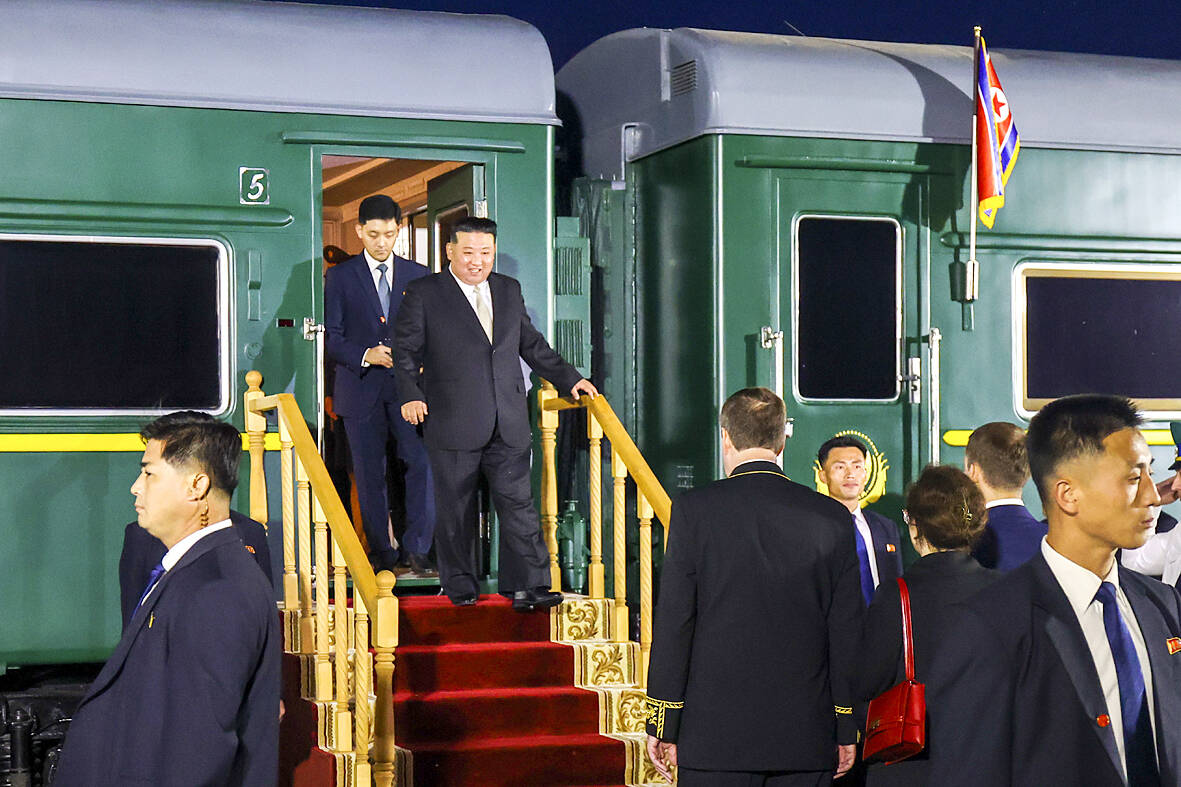Joe Biden has Air Force One; Rishi Sunak a fleet of RAF jets and helicopters. But when Kim Jong-un makes one of his rare journeys outside North Korea, he has an armoured train in which to while away the hours.
The North Korean leader’s dark green train crossed the Russian border on Tuesday in advance of talks between Kim and Vladimir Putin on supplying the Kremlin with munitions for the war in Ukraine.
The trip is Kim’s first outside North Korea since the COVID-19 pandemic forced the country to close its borders, and his second meeting with Putin since the leaders held talks in Vladivostok in April 2019.

Photo: AP
The summit will come at the end of a journey from the North Korean capital Pyongyang lasting an estimated 20 hours, during which Kim will have prepared and rested in luxuriously decorated carriages that moved at a snail’s pace through North Korea.
Kim does not reportedly share the fear of flying that forced his father, Kim Jong-il, to travel long distances exclusively by rail — he flew to his 2018 summit in Singapore with Donald Trump and to a meeting with the Chinese leader, Xi Jinping, the same year in the Chinese city of Dalian.
But the armored train, which includes bedrooms and a meeting room fitted out with wall-mounted lighting and reddish-pink leather armchairs, appears to be Kim’s preferred mode of transport. It took him 4,500km through China for his second summit with Trump, in Hanoi in 2019 — a journey that lasted two-and-a-half days.
Only a select few have seen the inside, including a Russian official, Konstantin Pulikovsky, who in his book Orient Express recounted fine-dining menus during a trip across Russia’s Far East with Kim Jong-il.
Passengers could choose from an eclectic range of dishes, including those from Korea and Japan, and a wine list that included Bordeaux and Burgundy, Pulikovsky wrote, adding that entertainment was provided by young female singers referred to as “lady conductors.”
Protection for the line of North Korean dynastic leaders — who are reportedly paranoid about their personal security — comes from plates of armor installed beneath carriages used as living quarters and meeting venues.
According to South Korean media reports, North Korea has 90 special carriages in total and operates three trains in tandem when a leader is traveling — one in front that handles security checks, one carrying the leader and his immediate entourage and another behind for bodyguards and other personnel.
About 100 security agents are sent to stations en route to sweep for bombs, the newspaper said, citing information provided by South Korean and US intelligence, and testimony from North Korean defectors. As Kim’s train nears a station, the power on other tracks is shut off to halt the passage of trains in the area.
The train’s sheer size and the additional weight from armored reinforcements keep its average speed to a leisurely 60kph, giving Kim ample time to decide what he wants in return for the North Korean artillery shells and antitank missiles that have caught the eye of the Kremlin.
Kim is not the only official to have travelled abroad from North Korea by rail, however; in 2021, a group of Russian diplomats and their families made the journey home on a hand-powered rail trolley.

May 11 to May 18 The original Taichung Railway Station was long thought to have been completely razed. Opening on May 15, 1905, the one-story wooden structure soon outgrew its purpose and was replaced in 1917 by a grandiose, Western-style station. During construction on the third-generation station in 2017, workers discovered the service pit for the original station’s locomotive depot. A year later, a small wooden building on site was determined by historians to be the first stationmaster’s office, built around 1908. With these findings, the Taichung Railway Station Cultural Park now boasts that it has

Wooden houses wedged between concrete, crumbling brick facades with roofs gaping to the sky, and tiled art deco buildings down narrow alleyways: Taichung Central District’s (中區) aging architecture reveals both the allure and reality of the old downtown. From Indigenous settlement to capital under Qing Dynasty rule through to Japanese colonization, Taichung’s Central District holds a long and layered history. The bygone beauty of its streets once earned it the nickname “Little Kyoto.” Since the late eighties, however, the shifting of economic and government centers westward signaled a gradual decline in the area’s evolving fortunes. With the regeneration of the once

The latest Formosa poll released at the end of last month shows confidence in President William Lai (賴清德) plunged 8.1 percent, while satisfaction with the Lai administration fared worse with a drop of 8.5 percent. Those lacking confidence in Lai jumped by 6 percent and dissatisfaction in his administration spiked up 6.7 percent. Confidence in Lai is still strong at 48.6 percent, compared to 43 percent lacking confidence — but this is his worst result overall since he took office. For the first time, dissatisfaction with his administration surpassed satisfaction, 47.3 to 47.1 percent. Though statistically a tie, for most

In February of this year the Taipei Times reported on the visit of Lienchiang County Commissioner Wang Chung-ming (王忠銘) of the Chinese Nationalist Party (KMT) and a delegation to a lantern festival in Fuzhou’s Mawei District in Fujian Province. “Today, Mawei and Matsu jointly marked the lantern festival,” Wang was quoted as saying, adding that both sides “being of one people,” is a cause for joy. Wang was passing around a common claim of officials of the People’s Republic of China (PRC) and the PRC’s allies and supporters in Taiwan — KMT and the Taiwan People’s Party — and elsewhere: Taiwan and